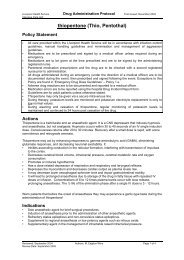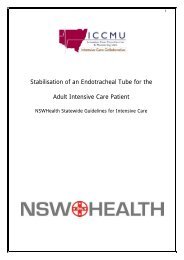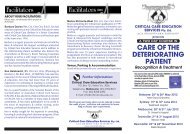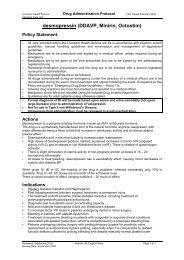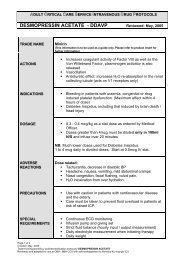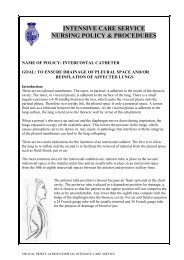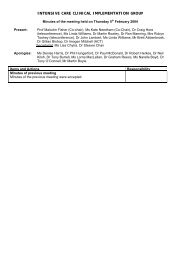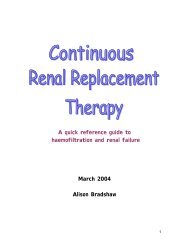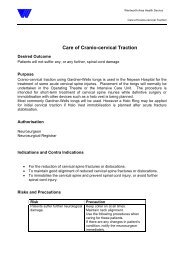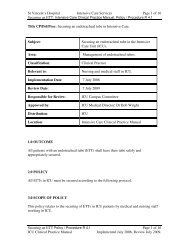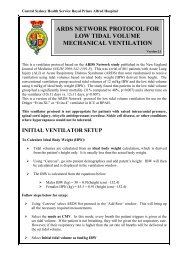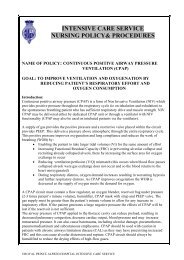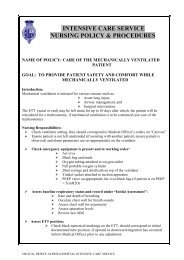Nursing care of the ventilated patient (SWAHS) - Intensive
Nursing care of the ventilated patient (SWAHS) - Intensive
Nursing care of the ventilated patient (SWAHS) - Intensive
Create successful ePaper yourself
Turn your PDF publications into a flip-book with our unique Google optimized e-Paper software.
W e s t e r n<br />
S y d n e y<br />
A re a H e a lth S e rv ic e<br />
H E A L T H<br />
<strong>Nursing</strong> Care Of The Ventilated Patient<br />
<strong>Intensive</strong> Care<br />
Evidence Based Practice Guidelines<br />
2003<br />
• If <strong>the</strong> <strong>patient</strong> is not being fed enterally <strong>the</strong> NG tube should be on free drainage and<br />
aspirated and flushed 6 hourly with water.<br />
• If <strong>the</strong> enterally fed <strong>patient</strong> has large aspirates (>200mls or > 4 hours feed) consult<br />
with medical staff regarding reducing <strong>the</strong> feed and/or discarding <strong>the</strong> aspirate.<br />
O<strong>the</strong>rwise <strong>the</strong> aspirate is generally returned if less that 200 mls or < 4 hours feed.<br />
• Elevating <strong>the</strong> head <strong>of</strong> <strong>the</strong> bed to 30 - 45 degrees (unless contraindicated) is effective<br />
in reducing <strong>the</strong> risk <strong>of</strong> aspiration.<br />
• Elimination should be recorded and aperients given if necessary.<br />
Genital/Urinary Tract:<br />
• IDCs predisposes urinary tract infections.<br />
• Routine urinalysis should be twice a day<br />
• Regular penil/perineum ca<strong>the</strong>ter <strong>care</strong> should be done.<br />
• The ca<strong>the</strong>ter should be secured to <strong>the</strong> leg <strong>care</strong>fully and repositioned as necessary to<br />
prevent pressure areas.<br />
• Hourly urine monitoring is carried out and medical staff informed <strong>of</strong> abnormally high<br />
or low measurements. Aim for a urine output <strong>of</strong> 0.5ml/kg.<br />
Repositioning And Pressure Area Care:<br />
• Attending to <strong>the</strong> <strong>patient</strong>’s hygiene protects <strong>the</strong> skin and ensures dignity and comfort<br />
• Ventilated <strong>patient</strong>s are at a higher risk <strong>of</strong> developing nosocomial infections and<br />
pressure areas due to <strong>the</strong>ir immobility, <strong>the</strong>ir underlying disease process and <strong>the</strong><br />
presence <strong>of</strong> invasive monitoring lines and equipment.<br />
• Repositioning <strong>the</strong> <strong>patient</strong> regularly has a number <strong>of</strong> positive effects:<br />
� routine turning and positioning assists in <strong>the</strong> mobilization <strong>of</strong> secretions<br />
� prevents <strong>the</strong> development <strong>of</strong> pressure areas, joint stiffness and deformities<br />
� improves oxygenation and can encourage weaning from <strong>the</strong> ventilator.<br />
� provides a different view on <strong>the</strong> environment for <strong>the</strong> <strong>patient</strong><br />
� <strong>the</strong> <strong>patient</strong> should be repositioned 2 nd hourly if possible, taking <strong>care</strong> to<br />
position <strong>the</strong> limbs in proper alignment and supporting <strong>the</strong>m to prevent<br />
dependant oedema.<br />
• If <strong>the</strong> <strong>patient</strong> has leg splints on <strong>the</strong>y should be on for 2 hours and <strong>of</strong>f for 2 hours.<br />
They should not be bandaged and <strong>the</strong> skin integrity should be checked with each turn.<br />
•




